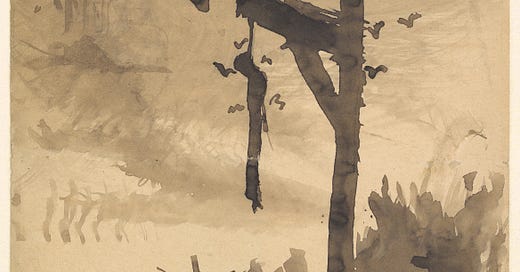(I)
We are immobilized; our bodies collapsed there in that dark space. It is the beginning of the infantilization of our body. Body firmly pressed there in the chair. When will it begin? — The cinema. Eyes wait for light in the front, on the screen. As the moving images fall on the screen, we, chair-clamped as we are, tend towards control. Our eyes, with their roaming ability, take its position. It substitutes the camera, the lens. This is what the camera intended when it shot the film—to become the eye of the viewer, to give them an illusion of authority, the perfect knowledge.
The camera makes the eye see—the distant, the past, the future... It provides a sense of omnipresence. Our psyche, predominated by light restored at one thick space in a completely dark hall, begins to fantasize; the credulity appears in front. We begin to believe whatever is happening on the screen. In most of the cases, we are completely taken in. We begin to identify with the person on the screen, as it’s essential to have leisure, pleasure. Our body condenses into the character's activity, whom we most identify with. The narrative makes it more plausible—the identification.
This identification causes us to believe that the death in An Occurrence at Owl Creek Bridge somehow is also the death of the viewers, of us. Not in the literal sense though, but in the sense that some sort of identification with that image begins to swirl inside the head, and in turn one begins to ponder about this taken-aback death. Our identification with it dies in that instant.
(II)
A body is hanged. Head tilted, below the neck, the torso is in line with rope—the posture is of an Italian mummy, though un-anointed, knees are tied, and so are the ankles. The body dies, so do the experiences this body bores. A death occurred, in its finality. It can’t be stalked after now—we can’t know about it. It happens regularly as one thinks about death; one wants to know what comes after it. But the sadness is that as one dies, imbibed experiences sink into a vacuum—accessible to none. One can’t chronicle it—the aftermath.
One can attempt to chronicle dying though, the moment before death, which very film aspires to inform us. We hardly dread death. We dread the moment before death—the dying, when life piles over our heads, beginning to collapse. The moment when someone learns their entire existence is going to be scratched and never restored. It will be deleted and not archived. This heightened the terror.
The first time we met him—his demeanor tense, his body arrested. The noose is being prepared. Death is about to occur. For these soldiers, it’s death they are targeting. For the person, it’s the dying he has to penetrate.
On one side of the plank stands a soldier, extending it outside the bridge, above the water, hammered he, to the plank as an image, to be mutilated.
His eyes swirl, his nose flutters, his lips shut—his expression is economical, primordial. Eyes on the hunt. It pans. It pierces—whatever is around it. It’s a scrutiny of some sort. To distract fear, to transmit it out. This practice of looking to inquire for a second sets out control for himself over himself and then over others. It’s a postponement of dying—this is a dispatchment out of his agony.
In a moment, his knees are bound, as are his ankles—abruption in control, it is plucked out. He closes his eyes. He shouldn’t have. Dying takes its position to inflict more pain. Indeed, for both of us—for the viewers, for the bearing body. The closing of eyes, the beginning of memory so edged, the creation of imagination so lucid, agony aches to arise.
The soldier gets off the plank, and the man falls in the water like timber sweeping in, like a bullet being fired. He was packed in a rope, like inside a sack; mummified, he fell in the water. He unmummified himself; unfisting, he ascended and came out of the water. He screams as he ascends. He comes out of a near-death experience. Three times, he rescued himself.
He comes out alive despite the repetitive targeting and constant shooting. All this effort his mind put into—experiencing nature, being in dirt there, and then meeting his wife—seems as an addition to his torture. His imagination was so wild that he even reached there to his wife to die once again. His is twice death—the end of imagination with the end of him.
(III)
Heidegger1, in his conception of being-towards-death, proposed that death is non-relational. Non-relational in a way that to have the experience of death, one has to die. One won’t be able to experience it out of the other's death. While in the first sense, the awareness of death comes to us as others die, though the experiences of death evaporate as others die, as we die. The aftermath is unreachable.
But cinema as a medium possesses the ability to make this—the experience of death, not after it—accessible to its viewer. It produces an illusion where death seems graspable, reachable, and touchable.
As it happens throughout the film, duped as we are, quite slowly we begin to believe in the happenings there. We identify with his desires and demands and his very fantasy. We run as he runs. Every time he rescues himself, we feel content. Our eyes wander with him; wherever he runs, our eyes run, body stiff, eyes prowl. The anticipation of him embracing his wife means our eyes receiving her. Eyes substituted our body. The body grows inanimate, the eyes more alive—as the scene unfolds. As he got hanged, failing to embrace her wife, both happening at different planes—our eyes so surprisingly fell outside of both planes. That viewing eye got hooked, hanged, as did the character’s body, on what happened. Death seizes the eye; in a sense, the eye dies.



